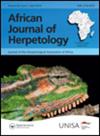Advertisement call description of the exceedingly rare Phrynomantis affinis (Anura: Microhylidae), with comparisons to P. bifasciatus and range extensions for both species
IF 0.9
4区 生物学
Q2 Agricultural and Biological Sciences
引用次数: 0
Abstract
ABSTRACTDespite a relatively broad distribution in Africa, the Spotted Rubber Frog, Phrynomantis affinis, is extremely rarely encountered. Only 18 specimens from 12 localities have been collected with a few additional observations recorded. Virtually nothing of the species’ natural history is known. We report or summarise new localities and range extensions of P. affinis in Namibia and Zambia and describe the call for the first time. We also compare its call to that of the sister species, P. bifasciatus, describing this call for the first time and noting a considerable range extension. The calls show several key differences, with P. affinis calls generally having a lower dominant frequency, pulse repetition rate, and number of pulses than P. bifasciatus. The calls of Namibian and Zambian P. affinis also show marked differences. These descriptions add valuable natural history information for both species and will considerably improve the field detection of the enigmatic P. affinis.KEYWORDS: advertisement callbioacousticsPhrynomantis affinisrange extensionrare species AcknowledgementsThis work was conducted under the Namibian Commission on Research, Science and Technology permit number AN20191118. We thank Schalk W. van der Merwe for access to farm Marne. We acknowledge the late Alex Duff-Mackay for recordings from Kenya. We also thank Frank Willems and Derek Solomon for their valuable recordings from Zambia, including the video-confirmed range extension for P. affinis by F. Willems.Disclosure statementNo potential conflict of interest was reported by the author(s).极为罕见的affinis Phrynomantis(无尾目:小水螅科)的广告电话描述,与P. bifasciatus的比较和两种物种的范围扩展
尽管斑胶蛙(Phrynomantis affinis)在非洲分布相对广泛,但却极为罕见。仅收集了12个地点的18个标本,并记录了一些额外的观察结果。事实上,人们对这个物种的自然史一无所知。我们报道或总结了在纳米比亚和赞比亚的新地点和范围扩展,并首次描述了这一呼吁。我们还将其叫声与姐妹物种P. bifasciatus的叫声进行了比较,首次描述了这种叫声,并注意到相当大的范围扩展。这些叫声表现出几个关键的差异,与双歧鱼相比,亲和鱼的叫声通常具有较低的主导频率、脉冲重复率和脉冲数。纳米比亚和赞比亚亲和鸟的叫声也表现出明显的差异。这些描述为这两个物种增加了宝贵的自然历史信息,并将大大提高对神秘的亲缘木的野外探测。关键词:广告callbiacoustic sprynomantis affininrange extension稀有物种致谢本工作在纳米比亚研究科学技术委员会许可证号AN20191118下进行。我们感谢沙尔克·范·德·默威让我们进入马恩农场。我们感谢已故的亚历克斯·达夫-麦凯在肯尼亚的录音。我们还要感谢Frank Willems和Derek Solomon在赞比亚提供的宝贵录音,包括F. Willems通过视频证实的affinis的扩展范围。披露声明作者未报告潜在的利益冲突。
本文章由计算机程序翻译,如有差异,请以英文原文为准。
求助全文
约1分钟内获得全文
求助全文
来源期刊
CiteScore
2.60
自引率
6.70%
发文量
0
审稿时长
>12 weeks
期刊介绍:
African Journal of Herpetology (AJH) serves as an outlet for original research on the biology of African amphibians and reptiles. AJH is an interdisciplinary journal that publishes original articles and reviews from diverse fields and disciplines, such as conservation, phylogenetics, evolution, systematics, performance, physiology, ecology, behavioural ecology, ethology, and morphology.
The Journal publishes two issues a year. There are no page charges .

 求助内容:
求助内容: 应助结果提醒方式:
应助结果提醒方式:


